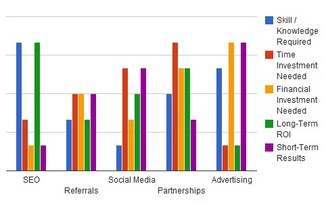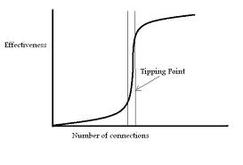 In Social Media Marketing the story length of what you want to sell may sound like a trivial concern, but believe it or not, it’s one of the most hotly debated topics in the sphere of online brand management services. On average, most article submission sites set the minimum word count at 500 words, but there’s no cap. I know a SEO agency that can rally behind the battle cry behind “the longer the better”... my SEO services advocate for conciseness and brevity. Less talk, less mistakes. Qualifying what “better” means To say that one thing is better than the other, there should be a set of criteria to quantify or qualify the claim. When it comes to the duel between short articles and long articles, some of the questions an SEO agency should ask are: - Will a short article generate more click-through compared to a long one and vice versa?
- Does length actually impact the number of views your content gets?
- Does word count have a bearing in terms of SERP performance in Google?
- Does brevity or otherwise encourages more syndication?
To settle this battle of length once and for all, can an SEO agency stake its credibility and point blank provide answers to the questions posted above? The reason that this big enigma in brand management services is still being discussed is because no one can present irrefutable proof that a short article would outperform a long article and vice versa. Content first before length The reality is, the safest and probably most accurate settlement for this standoff is “it depends.” Specific topics, in order to serve the best information to an audience, needs to be explained lengthily. These are topics that have numerous dimensions and to omit even one will undermine the credibility and reliability of the material. On the flipside, there are topics that do not need to be belabored if you can already present a case in just 500 words. Or even less for that matter. The fact is, it’s up to the discretion of the content experts in an SEO agency to determine whether an article should be in-depth and detailed or short and sweet. It’s all about what the readers need when someone goes online and runs a search, he or she already have pre-set expectations on how long an article should be. IF YOU WANT HELP ABOUT THIS ISSUE, PLEASE ASK ME!
 Here are 5 steps you should use to guide your decisions and actions.
1. Identify which of the 4 types of traffic you’re going to focus on. Again, it depends mostly on what you prefer, the resources you have, and what you’re willing to invest (either time or money).
2. Create an overall strategy to guide your actions. For example, if you want 100 sales (at 2% conversions) then you’re going to need 5000 visits each month. Great – how are you going to get them? Break that number down by identifying where you’re already getting traffic, or which tactics need to increase to make up the difference.
3. Now narrow down to the individual channels you’re going to use. Measure their performance, and figure out how much you can improve each. For example, to increase visits from Facebook you could post more frequently, use better headlines and images, or try to increase engagement by running contests. Or maybe you’re all tapped out on your existing channels, so you need to start using new ones like Google AdWords or Facebook Advertising. These are small examples, but hopefully you get the picture.
4. Turn the “winning tactics” into a repeatable process. Now figure out how you can you scale these winning tactics. Maybe you can use tools to automate and schedule social media posts. Or perhaps you can hire someone to help you do a lot of the manual labor.
5. Measure, test and iterate to find new tactics with a better ROI. You always want to be on the lookout for new tactics that will give you better results, for less time and money invested. So you should look around and see if there are new tactics or techniques you can use. Start small by investing only a little as a test, and watch your key metrics. For example, how much traffic does it send? And how is that traffic converting?
Based on Case Study: How to Generate More Traffic, Fixcourse.com
ASK ME HOW I CAN HELP YOU GENERATE MORE TRAFFIC!
 Nr.1 Get specific When you set yourself a goal, try to be as specific as possible. "Lose 5 kg " is a better goal than "lose some weight," because it gives you a clear idea of what your goal looks like and it's easy to measure your path for success. Also, it's a easy way to plan for specific actions that need to be taken to reach your goal. If you need to conquer a number of fans, likes, comments, visitors or affiliate sales, write your KPIs!
Nr.2 Seize the moment to act on your goals. Given how busy most of us are, and how many goals we are juggling at once, it's not surprising that we routinely miss opportunities to act on a goal because we simply can't deal with all the "fires". In social media, try to hire someone that manage content full time and act fast and smart concerning your network feedback and general behavior. Program routines to specific times and always focus on "a calendar" or a "To Do list".
Nr.3 Know exactly how far you have gone - measure! If you don't know how well you are doing, you can't adjust your behaviour or your strategies accordingly. Check your progress frequently -- weekly, or even daily, depending on the goal.
Nr.4 Be a realistic optimist When you are setting a goal, by all means engage in lots of positive thinking about how likely you are to achieve it. Most goals worth achieving require time, planning, effort, and persistence. Remember that in social networks you don't control nothing. That's the reason why you need to sell a story and experiences to engage and not all of them will interest your audience. So you must keep your good vibes, measure, adapt, measure, adapt, measure...you know: in life and business the cherry in the top of the cake often appears if you be patient and wait (many times) until the final curtain.
Nr.5 Focus on getting better, rather than being good. Normally we focus on goals that are all about proving ourselves, rather than developing and acquiring new skills. Embracing the fact that you can change to a better "state" will allow you to make better choices, and reach fullest potential. This is not easy to practice but people whose goals are about getting better (like doing a MBA) appreciate the journey as much as the destination. Advice: In the middle of each journey get advising from an outside social media consultant: this way you will have an independent opinion about your journey and about your "comfort Zone".
Nr.6 Be resilient - effort, planning, persistence, and good strategies are what it really takes to succeed as said. Embracing continuous knowledge will not only help you see yourself and your goals more accurately, but also do wonders for your ego. Stay focus on what your customers and other network actors say about your product and service and never get tired to pursue new improvements. But take care: don't change too often your message or product because if you do it you will impoverish it.
Nr.7 Build your willpower muscle Your self-control "muscle" is just like the other muscles in your body -- when it doesn't get much exercise, it becomes weaker over time. Be alert about all the challenges around your product or network discussions but think wisely about if all the challenges deserve your attention or risk. Be strong not to follow everything that moves. Be Nr.1 and Nr.2.
Nr.8 KISS - Keep It Simple, Stupid. It's hard to be simple in our world. There is to much information and means. Even if you have a great idea or a project already to implement, think again about your strategy and processes! Whatever people could say to you, the shorter distance between two dots is always a single line. Try to think about it first and try not to complicate! Your network members will appreciate light things. Don't give them problems for them to think about or loose their time trying to discover what you want really want. Go simply to the point but be creative!
Nr.9 Focus on what you will do, not what you won't do Do you want to successfully lose weight, quit smoking, or put a lid on your bad temper? Then plan how you will replace bad habits with good ones, rather than focusing only on the bad habits themselves. In Social media, try to focus on product road map and PR strategy rather than thinking about what to avoid. It's not easy but you can get help for an outside media consultant or consulting firm to help design your road map.
 Regarding one of the most used social networks, Facebook, let’s take a look to what you should pay attention to.
These metrics will help you make decisions about your engagement and content strategy that would allow you to build more effective interactions with your public:
1. Weekly or Monthly fan size growth: Periodic track the number of fans (or “Likers”) to see what your growth looks like. If you are growing organically and you have 10% monthly growth, you are doing extremely well! Whatever you decide to do, make sure to watch for the spikes in fan growth and try to identify what contributes to it.
2. The average number of Likes or comments: These are your engagement measures. If you know the average number of time fans interacted with you for every single post, you will be able to identify which discussions are of more interest to your fans. This is a good metric because it is extremely helpful in making immediate decisions in your content strategy and changes. Increase the number of posts around the topic your fans are more engaged with and decrease the number of posts around topics they are not interested in.
3. Unlikes and attrition rate: The fact is that you will always have some unsubscribes, no mater how great your engagement is, but hopefully it is just a small number. You want to try to correlate them with the activity on your page and understand why people are leaving. It is rather hard to nail down the exact reason, but if there is an unusual spike, you will usualy have a pretty good idea. The simple attrition rate formula is: Daily Unlikes / Daily Fan Count
4. Demographics: No matter what your objectives are, you can always find the demographics data useful: the gender of your fans, their ages and where they are from. This is vital for you for direct marketing campagins and understand your Target behavior in a granular way.
5. Page views helps you identify the number of returned fans. If you take the number of page views and subtract the number of unique page views, you will see how many of your fans are actually coming back to your page. You can also look at the Daily Active Users metric.
6. Mentions: This is a cool metric - the number of times someone tagged you in their post. The reason why this is important is because it is the easiest way for your fans’ friends to click through to your page. Every time someone tags you, the name of your Page appears as a link. It is much easier for someone to click on that link and learn more than to search for your Page manually.
7. Tab views If you have multiple tabs on your page, it will tell you which tab gets what percentage of traffic. This metric will help you decide on whether you would want to keep or maybe get rid of some of your tabs.
8. Referrers: Another new metric that tells you where the traffic to your page comes from. You want to increase exposure to your page on the sites that bring you the most traffic.
9. Affiliations If you have an Affiliation program where you put other persons trying to sell your brand by a % of the sales than you need to measure it. Here the % of sales Vs nr. of persons selling for your is your metric.
10. Impressions: If your page is over 10,000 fans, you will see the number of times your post was viewed –- impressions. This metric is not exact since every time someone’s page refreshes, it counts as an impression
_
_
 _
Social media is about engagement...it's not like traditional marketing, pushing a message one way only: social media is user centric, not about a product! And you must have your target profiling very well defined before starting this journey. Create content: social media stages an interactive story about a product or service, enabling multiple interactions, from sharing, commenting, to playing with the story! Don't forget to lead this journey but let your followers and the experience breathe!
1. Embrace the Age Get involved: you must really believe that old marketing rules are almost dead and you must start doing social media campaigns and events in the same professional way you do with the traditional channels. You can have a part of it outsourced but you need your own specialized force to make it happen - one human resource only making comments or tweeting things is not enough: I'm talking about serious work on a social media strategy.
2. Know your target feedback How do your clients behave concerning your products/services?
Use the Net Promoter Score (NPS): Customers respond on a 0-to-10 point rating scale and are categorized as follows:
· Promoters (score 9-10) are loyal enthusiasts who will keep buying and refer others, fueling growth.
· Passives (score 7-8) are satisfied but unenthusiastic customers who are vulnerable to competitive offerings.
· Detractors (score 0-6) are unhappy customers who can damage your brand and impede growth through negative word-of-mouth.
To calculate your company’s NPS, take the percentage of customers who are Promoters and subtract the percentage who are Detractors. Now compare to other companies. Amazon is on 75%, for example (and that's very high).
3. Now decide if your company is ready for a social media campaign Most companies shouldn’t open themselves up in social media until they’ve earned respect. Is your product at a "five starts" level? Chris Brogan also wrote that "you shouldn’t push a social campaign unless you have pre-existing trust and relationships in social media". Focus on a number of followers you need and target it. Feed your network. Nurture the relationships. Deep study your target group and study the launch of the campaign (decide if you want to start with all your group or a sub-target).
4. Align all the channels and make sure you have a FIT You must align the release of a new product/service and the launch of a new campaign; you should have all other sales and marketing channels aligned with the social media channel. You must grant you have a FIT between your company values, the campaign and the followers' profiling. Make sure you have all the analytical tools ready to measure it.
5. You feel ready and things can get viral you know you're ready and you'll launch a new campaign or more actions when you feel you have the quality and the number of connections you need to be effective in the social media. Just a reminder: this is a no turning back point and you have already made a big journey until here ...but in social media there is no guarantee that it will be a blast! As a matter of fact the success is more dependent from the story you tell, from the experience you are giving, form the quality of the product and the compromise your company made, as a all, than any other variable.
And don't forget to make it with the help of a Social media professional because when things go wrong in a potential viral ambient, they spread even faster!
 There's no interest in building a Social Strategy if you don't know your customers! Look for professional help to do it - don't make only a pallid appearance because that's the new SPAM species and you'll put your brand in bad sheets! Social Networks or other digital marketing strategies only represent some ROI if you really understand your customers' needs and wishes. You must study closely their behavior and you need to measure constantly the impacts of each campaign! There are 5 step stones to do it. I can't go deep inside each one because there is a lot to talk and work around each:
1. Profile your target and start with a very small sub-group that have a strong brand awareness - study their consuming behaviors and other consumption preferences : they are your brand ambassadors - they will do the buzz you need to attract followers. If you don't have none, "fabricate"!
2. The BEST FIT: Align your strategy with your public - question your ambassadors what do they like or find unique in your brand, product or service. Try to understand what you could do even better to surprise them, exceed their expectations - build the App or Campaign based on this! This is the motive nr.1 for WOM.
3. Delivery a life time Experience: The social Apps must engage the consumer trough an emotional event or other kind of active behavior with the brand, product or service. Can they make money with it? Can they create something? Can they have fun? Be unique? Motive nr.2 for WOM.
4. Response control: you must have someone to supervise or have enough time to do it yourself - You really can't predict consumer behavior and the action impacts in social networks but if you manage closely the movements, you can act quick!
5. Measure: You must use the analytic tools you can to measure and adapt constantly the Campaign or App. You must define some KPIs! If you don't use any analytic backoffice you won't be able to see numbers, present results and react. This is particularly important if your social strategy is an e-commerce page on Facebook or an affiliate selling App where there are % on revenue.
|









 RSS Feed
RSS Feed